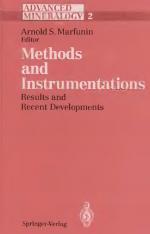Добрый день, Коллеги. Важное сообщение, просьба принять участие. Музей Ферсмана ищет помощь для реставрационных работ в помещении. Подробности по ссылке
Advanced mineralogy. Methods and instrumentations. Results and recent developments. Vol. 2
Changes in the methods of investigation have had a crucial impact on progress in mineralogy. Many important methods have emerged with their own parameters, interpretations, problems, new albeit restricted possibilities and scopes, and with their own instrumentation and measurement tools. Even the aims and contents of the investigations have changed. Two processes can be discerned:
1. The logical completion of developing and elaborating the methods, i.e. determining all physical principles based on a single, general, multifaceted phenomenon: the interaction of radiation (particles) with matter.
These interactions and hence these methods can be presented schematically by two coordinates. One is energy (or wavelength of radiation) and parts of the electromagnetic spectrum (nuclear, X-ray and electron, UV, visible, IR, microwave, SHF and RF). The other coordinate is represented by the modes of interaction (spectroscopy-absorption, emission, scattering-diffractometry, microscopy). The various intersection points in this system of coordinates have already been determined and elaborated in detail according to theoretical and instrumentational aspects.
2. The natural, ultimate possibilities of the methods were then realized with the new generation of instruments. Their development from 1960-1990 puts into effect the principles of interaction of radiation with matter and brings them to the limits of detection, accuracy, and precise determination. Furthermore, it allows the complex measurement of small and diverse objects.
Completely new spectroscopic methods, developed in the last decades, resulted in an enormous volume of new data on mineral matter. These include: nuclear gamma resonance (Mossbauer) spectroscopy, all variants of X-ray and photo-electron spectroscopy, optical absorption spectroscopy, all types of luminescence, infrared and Raman spectroscopy, electron paramagnetic resonance, and nuclear magnetic and nuclear quadrupole resonance. In a short time, some decisive changes regarding these new methods have taken place, opening even greater possibilities: e.g. synchroton radiation in X-ray spectroscopy, development of EXAFS, XANES, ESCA, Auger methods, laser excited IR, Raman and luminescence spectra, MASSNMR, spin-echo in NQR, and electron-hole centers in EPR. <...>




